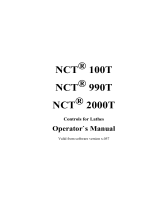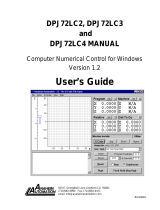
Operating and programming manual.
CNC 8060
CNC 8070
·4·
(REF: 1811)
CHAPTER 4 AUTOMATIC MODE: PROGRAM.
4.1 Program execution......................................................................................................... 71
4.1.1 Program selection. ..................................................................................................... 71
4.1.2 Execute a program..................................................................................................... 72
4.2 Cancel the execution and resume from the same block................................................ 73
4.3 Cancel the execution and resume from another block while keeping the history. ......... 74
4.4 Tool inspection............................................................................................................... 75
4.5 Change the machining conditions (MHFS mode). ........................................................ 77
4.6 Display/hide the dynamic override................................................................................. 77
CHAPTER 5 MANUAL MODE.
5.1 Operations with the axes. .............................................................................................. 81
5.1.1 Machine reference zero (home) search. .................................................................... 81
5.1.2 Jog ............................................................................................................................. 82
5.1.3 Jogging the axes with handwheels ............................................................................ 84
5.1.4 Moving an axis to a particular position (coordinate)................................................... 86
5.1.5 Coordinate preset ...................................................................................................... 86
5.2 Setting the feedrate. ...................................................................................................... 87
5.3 Setting and activating the zero offsets and the fixture offsets. ...................................... 87
CHAPTER 6 EDISIMU MODE.
6.1 Functionalities of the editor............................................................................................ 91
6.1.1 Contextual programming assistance.......................................................................... 92
6.1.2 Help for programming subroutines............................................................................. 93
6.2 Select a program. .......................................................................................................... 94
6.3 Operations with blocks................................................................................................... 94
6.3.1 Copy, cut and paste. .................................................................................................. 94
6.3.2 Find a line or a text in the program. ........................................................................... 95
6.4 Undo and redo. .............................................................................................................. 95
6.5 Operations with files. ..................................................................................................... 96
6.5.1 Import DXF files ......................................................................................................... 97
6.6 Syntax errors when editing ............................................................................................ 99
CHAPTER 7 MDI/MDA MODE.
7.1 Edit and execute individual blocks............................................................................... 103
7.2 Block history. ............................................................................................................... 104
CHAPTER 8 TECHNOLOGY TABLES.
8.1 Material files................................................................................................................. 106
8.1.1 Where the CNC saves the material files (material_file.xml)..................................... 108
8.1.2 Viewing a material file. ............................................................................................. 108
8.1.3 Creating, renaming and duplicating a material file................................................... 109
8.1.4 Deleting a material file. ........................................................................................... 109
8.1.5 Importing and exporting material files. ..................................................................... 109
8.1.6 Protecting technology tables with a password. ........................................................ 110
8.2 Cutting and piercing parameters.................................................................................. 112
8.2.1 Selecting and activating a material file. ................................................................... 115
8.2.2 Adding or deleting parameters (only OEM).............................................................. 115
8.2.3 Modifying the properties of the parameters. ........................................................... 115
8.2.4 Enter password. ...................................................................................................... 116
8.3 Setting the properties of the material file parameters. ................................................. 117
8.3.1 Operations with material files................................................................................... 119
CHAPTER 9 MACHINE STATUS.
9.1 Monitoring of digital and analog inputs. ....................................................................... 121
9.2 Monitoring of digital and analog outputs. ..................................................................... 122
9.3 Status of the axes. ....................................................................................................... 122
9.4 Laser status. ................................................................................................................ 123
CHAPTER 10 USER TABLES.
10.1 Zero offset tables ......................................................................................................... 126
10.2 Fixture table ................................................................................................................. 128
10.3 Arithmetic parameter tables......................................................................................... 129
10.4 Operations with tables ................................................................................................. 130
10.4.1 Data editing.............................................................................................................. 130
10.4.2 Save and recall tables.............................................................................................. 130























